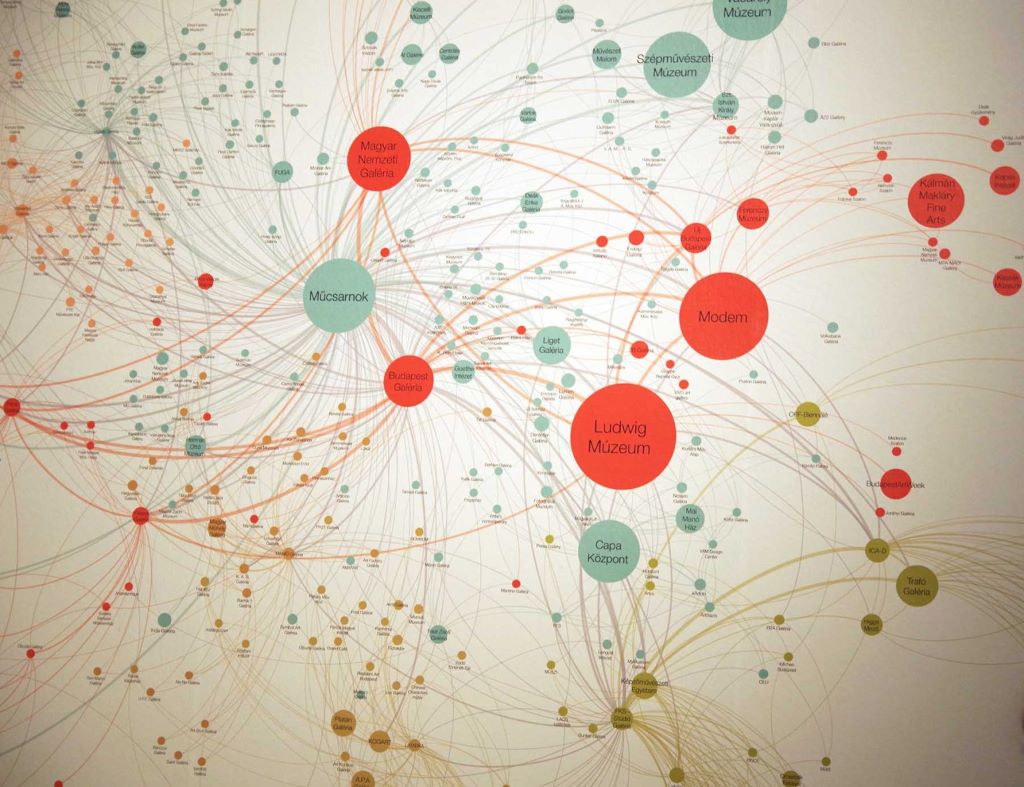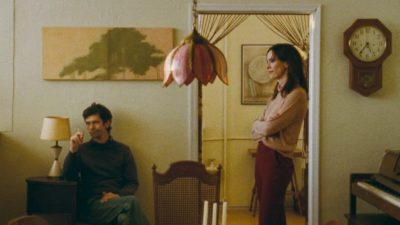BarabásiLab: Hidden Patterns – The Language of Network Thinking opened on the 10th October in the Ludwig Museum Budapest. As part of the CAFe Budapest Contemporary Arts Festival, the exhibition exposes some main projects of the research lab of Hungarian physicist and network researcher Albert-László Barabási. We can see network visualisations, 3D data sculptures, videos, and VR data showcases.
Barabási has been working in this field for 25 years. In his research, his main focus is to seek for (usually invisible) connections between things and/or phenomena, as well as recurring patterns. Networks are really everyhere: in nature, in society, in language, in culture, and they are also connected to each other.
The idea of this exhibition came 2 years ago, when he asked the designer in his lab to collect all data visualisations from the last 20 years. Then they realised what an exciting material they actually have, also for a possible broader audience.
Ludwig Museum launched a private guided tour for the press a day before the exhibition was officially opened. Curator József Készman explained that it is nothing new in the exposure of works from the borderline of arts and science, but it is indeed new that the Hidden Patterns solely focuses on the works by Barabási’s lab.

The common point is visuality that connects science to arts. Albert-László Barabási aims to give the arts back what he borrowed from them, as the discoveries of network research are only understandable if one can showcase them visually.
Albert-László Barabási recalled that he wanted to be a sculptor during high school, but in that situation it seemed to be a better decision to study physics. However, as a network researcher, he has always found visuality very important, and 3D painting was an important addition to his work.

In one project, for instance, Barabási analysed various national gastronomic traditions, discussing how flavour compounds have an impact on the ingredients, with a network-centred methodology.
“We analysed which are those molecules responsible for the taste that are common in the given raw materials, and they are connected to each other if they have common molecules”
– Albert-László Barabási explained.
Life stopped in New York
In another hall, visualisations modeling the movements of humans can be seen. Barabási and his co-workers followed people through cell phones – the data was obviously anonymised. They could see whether certain individuals met each other. They used data to predict what would happen if an epidemic based on personal contacts stroke in. Their research helped to understand how a virus spreads within a country. BarabásiLab used data to create visualisations on the movements of the New York population during the covid-19 pandemic.
“This is a visualisation about post-covid-19 New York. You can see how smaller people’s movements are. It only seems to be a video on certain people moving or not, but for me, this video is about the 21st century. This is the moment when the new century is born. It shows how different we are now than we were before covid-19
– Barabási said.
One of the most often used visualisations of the BarabásiLab is an illness network published in 2007, which aims to explain in the language of mathematics which genes are responsible for what diseases, and what are their connections. This map used human genome to uncover explanations for genetically predetermined conditions. If two illnesses have a connection on the picture, it means that the same gene is responsible for them. One example could be a connection between obesity and diabetes, as the researcher pointed out.
Albert-László Barabási remembered how Hans Ulrich Obrist, the artistic director of a renowned English art gallery, Serpentine Galleries, asked him whether they can exhibit the image. That was the first time when a BarabásiLab picture arrived in an artistic context. The exhibition also reminds us how complicated and time-consuming it is to create and spatialise such a visualisation.

“People imagine that it is just pressing one button and all is ready, but our work is definitely not that easy, unfortunately.”
New are the works on Hungarian visual art networks that show how artists, curators and institutions are connected to each other. The institutional network shows such art galleries and other places that often exhibit works by the same artists. The images can be seen even more detailed as data sculptures with the help of VR instruments that are also present at the exhibition.

The exhibition is open until the 17th January in the Ludwig Museum. Organisers work with a time booking system to assure safety and quality of the visit. HERE you can book your time slot!
Article: Zsolt Várkonyi
Translation: Zsófia Hacsek

























Comments
2 Responses to “The 21st century started with the coronavirus, researcher behind the BarabásiLab exhibition implies”
THANK YOU VERY MUCH FOR THE INNOVATIVE THOUGHT AND AESTHETICALLY SOUND IDEAS OF TWENTIYFIRST CENTURY CONCEPTUAL ART. I AM AN ARCHITECT AND REGIONAL PLANNER AND DURING ALL THE YEARS OF MY PROFESSIONAL PRACTICE I HAD ENCOUNTERED VERY COMPLEX NETWORKS WHICH I DID NOT HAVE THE KNOWLEDGE TO COPE. BUT NOW WITH THEEXPLATIONS ABOUT NETWORKS AND HIS RECENT BOOK, I AM GRATEFUL TO ACKNOWLEDGE THE ASSISTANCE OG DR, BARABASI.
I AM LUCKY TO COME TO CONTACT OF THE SCIENTIFIC THEORIES OF DR. LAZLO BARABASI. THANK YOU AGAIN FOR THE INSIGHT. NICHOLAS M. HADJITHEODOROU. ARCHITECT URBAN AND REGIONAL PLANNER. PROFESSOR EMERITUS OF LA VERNE UNIVERSITY. THE USA. ATHENS GREECE ANNEX GREECE,